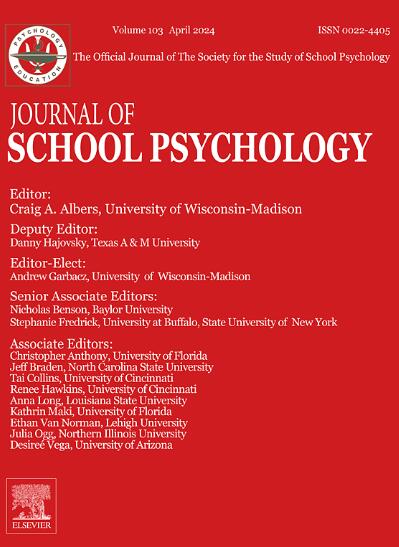The differences in school refusal networks among Chinese adolescents under varying cumulative ecological risks
IF 4.1
1区 心理学
Q1 PSYCHOLOGY, SOCIAL
引用次数: 0
Abstract
The phenomenon of adolescent school refusal is closely associated with their ecological environment. While numerous studies have examined the impact of a single risk factor on adolescent school refusal, few have delved into the cumulative effects of multiple ecological risk factors across various backgrounds. This study surveyed 808 Chinese middle school students using a self-compiled cumulative ecological risk scale and a school refusal scale based on the cumulative ecological risk model. Networks of school refusal were constructed for students experiencing high and lower cumulative ecological risk, exploring network structural features and core symptoms of school refusal. Findings revealed commonalities and discrepancies in core symptoms between adolescents experiencing high and lower cumulative ecological risk. Among those with lower cumulative ecological risk, core symptoms included “boredom”, “burden”, and “avoidance of studying”. Conversely, among those with highecumulative ecological risk, core symptoms were “boredom”, “lack of planning”, and “study pressure”. Additionally, structural differences were observed in the school refusal networks between high and lower cumulative ecological risk groups. This study systematically delineated structural differences in adolescent school refusal networks and core symptoms across varying degrees of cumulative ecological risk, offering a foundation for scientifically preventing and effectively managing adolescent school refusal.
不同累积生态风险下中国青少年拒学网络的差异
青少年拒学现象与其所处的生态环境密切相关。虽然有许多研究调查了单一风险因素对青少年拒绝上学的影响,但很少有人深入研究不同背景下多种生态风险因素的累积效应。本研究采用自编累积生态风险量表和基于累积生态风险模型的拒学量表对808名中国中学生进行了问卷调查。针对高、低累积生态风险学生构建拒学网络,探索拒学网络的结构特征和核心症状。研究结果揭示了经历高和低累积生态风险的青少年在核心症状上的共性和差异。在累积生态风险较低的人群中,核心症状包括“无聊”、“负担”和“逃避学习”。相反,在累积生态风险高的人群中,核心症状是“无聊”、“缺乏规划”和“学习压力”。此外,在高、低累积生态风险群体之间,拒学网络存在结构性差异。本研究系统描绘了不同累积生态风险程度下青少年拒学网络和核心症状的结构差异,为科学预防和有效管理青少年拒学提供了基础。
本文章由计算机程序翻译,如有差异,请以英文原文为准。
求助全文
约1分钟内获得全文
求助全文
来源期刊

Journal of School Psychology
PSYCHOLOGY, EDUCATIONAL-
CiteScore
6.70
自引率
8.00%
发文量
71
期刊介绍:
The Journal of School Psychology publishes original empirical articles and critical reviews of the literature on research and practices relevant to psychological and behavioral processes in school settings. JSP presents research on intervention mechanisms and approaches; schooling effects on the development of social, cognitive, mental-health, and achievement-related outcomes; assessment; and consultation. Submissions from a variety of disciplines are encouraged. All manuscripts are read by the Editor and one or more editorial consultants with the intent of providing appropriate and constructive written reviews.
 求助内容:
求助内容: 应助结果提醒方式:
应助结果提醒方式:


